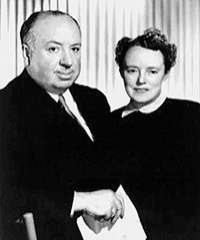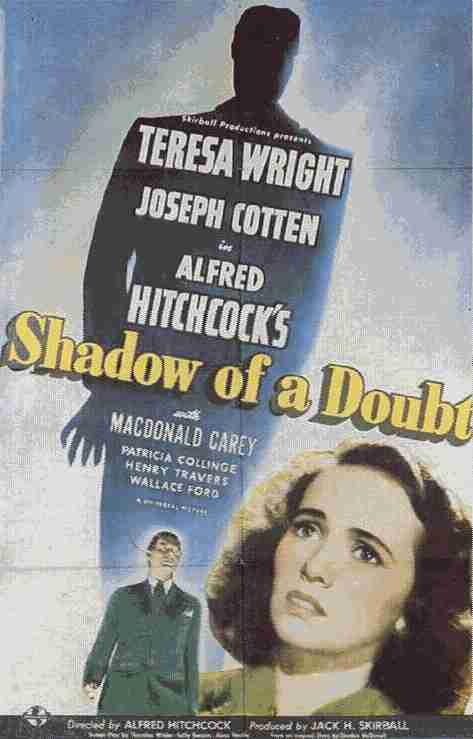Although
Hitch & Alma is a work of fiction, it offers a fairly accurate account of the latter part of Hitchcock's "golden period," roughly from the mid-fifties to the early sixties, when he was most prolific.While the story's secret collection of outtakes is completely fictional, there are many references within the various biographies on Hitchcock to some rather curious screen tests in which he reshot some of the famous scenes from his own past movies.
On one of these occasions, Tippi Hedren reprised the role of Ingrid Bergman from Notorious. Hitchcock purportedly had to destroy this footage afterwards, because he no longer had the legal rights to reshoot it.
During the 1998 restoration of Vertigo, it was revealed that there actually was an unused outtake intended for the ending of this masterpiece (although not the one in described in this story.) This unused scene was simply a tag-on ending at Midge's apartment, after Judy/Madeline's second plunge. Jimmy Stewart walks in just as the news of Galvin Elster's capture for the murder of his wife is announced on the radio.
During Hitchcock's 1967 interview with Francois Truffaut, he offered the Frenchman a similar outtake from Torn Curtain which depicted Wolfgang Kieling, the actor who played the East German Security Officer Gromik, in a role that never ended up in the final version. Kieling, made up in a wig and mustache, also played Gromik's factory working brother, who later meets with Michael Armstrong, the Paul Newman character, after Gromik's brutal murder. The scene was later cut from the movie.
Hitchcock also treated some of his later and more personal films with an unusual possessiveness, withholding masterpieces like Vertigo and Rear Window from the public for almost two decades. Some speculated he feared what imitators might do to these films. Mercifully, he never saw the procession of Psycho 2-5, or the Gus Van Sant remake of his original Psycho.
While we may never know if there are any secret outtakes by Hitchcock lying around somewhere, there's plenty of hidden meaning and secret portraits of himself and the people he loved to be found within his films.
Hitch&Alma points out some of the reincarnated characters that seem to pick up in life in one of Hitchcock's movies where they left off in another. This theme of character reincarnation is part of the Hitchcock signature, subliminally reinforcing the storytelling myth that ties together his entire body of work. Perhaps Hitchcock used these recurring characters, like the possessive mother, the falling man, the guilty woman, or the numerous portraits of family members and himself to imply we all exist on some deeper sphere of consciousness.
Any work of fiction based on the lives of real people will inevitably contain its share of inaccuracies. In a real sense, this story mythologizes Hitchcock and those around him. The most flagrant distortion of factual biography in this story centers around Hitchcock's mother, Emma. It should be stressed that all segments of the story involving Hitchcock's childhood and the Mother character are purely invention on the author's part.
In reality, Hitchcock was nothing but the devoted son, often taking his mother Emma along on vacations with Alma. Hitchcock's father died when he was still a young boy, and a deeper attachment between mother and her youngest son naturally resulted.
Hitchcock makes a far harsher judgment on himself in the way he portrays himself in his films. While everyone knows of his little appearances, few realize the sinister overtones that some of these cameos imply.
In Psycho, for instance, Hitchcock appears wearing a cowboy hat waiting outside the office window where Marion Crane works. Seconds later, the lecherous Larame, wearing the SAME cowboy hat, enters and plops down $40,000 on Marion's desk and almost propositions her, with Hitchcock's own daughter Pat looking on with great dissaproval as he tells Marion how he buys off unhappiness with money. Was Larame in this scene supposed to be Hitchcock's alter-ego?
A similar metaphor of Hitch's identification with his villians occurs in the seemingly innocent cameo of Torn Curtain. Here, Hitch almost appears to be an invalid, as he is pushed by a nurse in a wheelchair through an airport to meet an arriving friend. But then, Hitch vigorously jumps out of the wheelchair and walks off with the friend. This vignette exactly mirrors Shadow of a Doubt's Uncle Charlie's feigned malady on the train platform, which miraculously disappears as he jauntily marches to greet his namesake niece, while the train pulls out.
In the beginning of the movie I Confess, Hitchcock strangely appears walking through the desolate night streets of Montreal, seconds before the foreign born Church handyman Otto murders a man and flees down the same dark streets. Otto's wife, as mentioned before, is named Alma. Could this be Hitchcock's own confession of identity with this character?
Some photos and images relating to the real story behind
Hitch&Alma. This page will be occasionally updated.Posters courtesy of Martin Dawber from his site, Advertising Hitchcock


ÖA scene from
Hitch&Alma:INT. STUDIO OFFICE - DAY
Truffaut strokes his chin, thoughtfully studying Hitchcock, who seems far, far away.
TRUFFAUT: Why is it that in both Vertigo and Psycho, your leading ladies die in the middle of the movie?
HITCHCOCK: Well, in the case of Psycho, there was the wish to obtain the biggest star possible for the least amount of money.
Truffaut stares back, as if he doesn't believe a word.
TRUFFAUT: You don't like exposing yourself.
Hitch quickly peeks down, checking his fly.
HITCHCOCK: Well, who does?
TRUFFAUT: Were these two films your way of expressing a loss? Or perhaps of hoping to relive a lost passion?
HITCHCOCK(exasperated, like to a dull student): They were merely structural decisions, born of economic need on one hand, and storytelling on the other.
TRUFFAUT: And that's all there is to it?
Hitch looks annoyed by his persistence. The cool facade begins to crack from the pressure.
HITCHCOCK: What more do you want?


![]() A reading sample from Hitch&Alma:
A reading sample from Hitch&Alma:
![]() An interview with author of Hitch&Alma, Robert Schoen
An interview with author of Hitch&Alma, Robert Schoen
![]() Alma, the woman behind a very large man:
Alma, the woman behind a very large man:
![]() Hitchcock's Other Leading Ladies:
Hitchcock's Other Leading Ladies:
![]() The Mother in Hitchcock's films:
The Mother in Hitchcock's films:
![]() Hitch & Herrmann, artists with the same obsessive vision:
Hitch & Herrmann, artists with the same obsessive vision:
![]() Readerís and Web Site Visitorís Comments:
Readerís and Web Site Visitorís Comments:
![]() Book description and how to order a copy of Hitch&Alma:
Book description and how to order a copy of Hitch&Alma:
![]() Links to other Great Hitchcock Web Sites:
Links to other Great Hitchcock Web Sites:
![]()